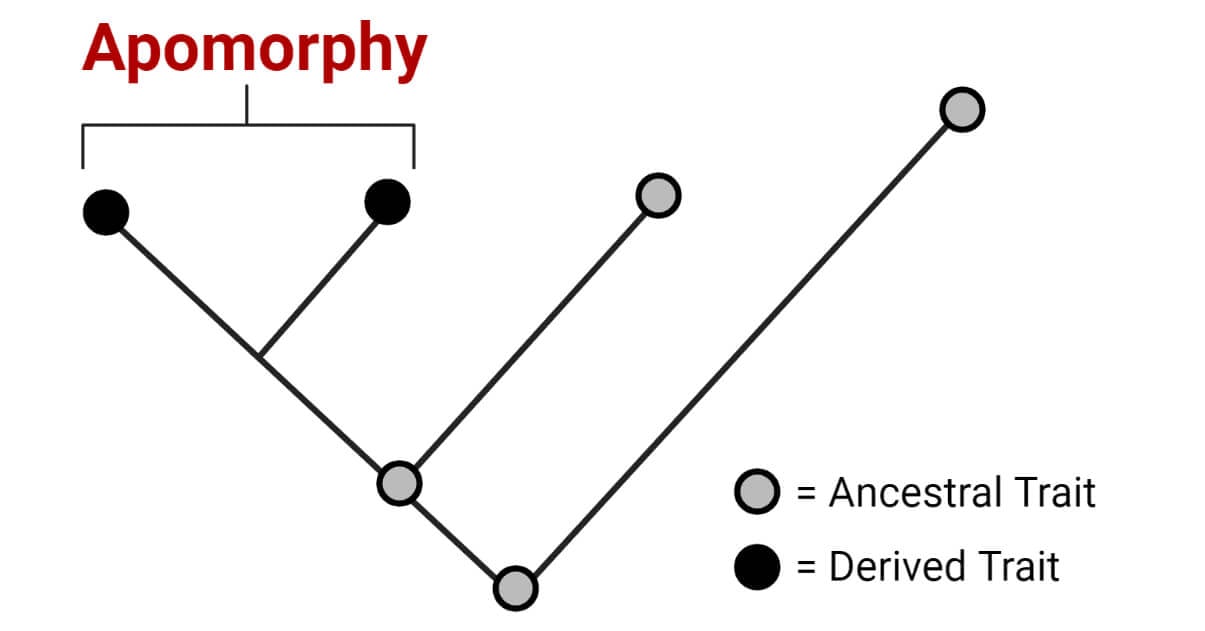Apomorphy is a term used in evolutionary biology to describe a derived or advanced characteristic or trait unique to a particular evolutionary lineage or species.
- Apomorphy is crucial in phylogenetic analysis, as it helps identify and define evolutionary relationships between different taxa.
- Apomorphies are distinguished from plesiomorphies, ancestral or primitive traits shared among multiple taxa.
- Apomorphies can manifest in various forms, including morphological features, genetic variations, and behavioral traits.

Likewise, it represents a departure from ancestral or primitive characteristics, known as plesiomorphies, and is considered a distinguishing feature of a specific taxonomic group.
Interesting Science Videos
Importance of Studying Apomorphy in Evolutionary Biology
- Apomorphy helps reconstruct and understand the evolutionary relationships between species, providing insights into common ancestry and divergence patterns.
- It is crucial to define and categorize taxonomic groups based on their unique derived characteristics and facilitate accurate biodiversity classification and organization.
- It represents evolutionary innovations and adaptations that have arisen within specific lineages. It also provides valuable insights into the mechanisms and processes driving evolutionary change.
- Apomorphy helps to identify adaptive traits that have contributed to the success and survival of organisms in their respective environments.
- True apomorphies are from traits that have evolved convergently. Besides, studying apomorphy allows researchers to disentangle complex evolutionary patterns and uncover the shared ancestry of different lineages.
The Mechanism of Apomorphy
Explanation of genetic changes and mutations
Apomorphy, or the development of uniquely derived traits, is driven by genetic changes and mutations. Genetic changes occur through alterations in the DNA sequence of an organism’s genome. These changes can arise spontaneously or due to external factors such as radiation, chemicals, or errors during DNA replication.
The mutation is a primary source of genetic variation upon which evolution acts. They can occur differently, including point mutations (single base substitutions), insertions, deletions, or gene duplications. These mutations introduce new genetic information into a population, potentially leading to the formation of apomorphies.
Role of natural selection in the fixation of apomorphies
Natural selection is a necessary driving force behind the fixation of apomorphies in a population. When a beneficial mutation occurs, individuals possessing the advantageous trait have a higher chance of survival and reproductive success, a process known as positive selection.
It increases the prevalence of advantageous apomorphy within the population, as individuals without the trait may be outcompeted or less successful in reproduction. Conversely, adverse selection acts against detrimental mutations or apomorphies that reduce an organism’s fitness.
Further, individuals with these unfavorable traits are less to survive and pass on their genes, decreasing the frequency of the unfavorable apomorphy over time.
It is essential to consider that natural selection does not work alone; genetic drift and gene flow also influence the spread or loss of derived traits within a population. Together, these factors shape the emergence and fixation of apomorphies, contributing to the diversification and adaptation of species throughout evolutionary history.
Significance of Apomorphy in Evolution
- Apomorphy drives speciation by creating reproductive barriers between populations, forming new species, and contributing to biodiversity.
- Apomorphies provide valuable information for reconstructing phylogenetic trees, helping scientists understand evolutionary relationships, patterns of common ancestry, and diversification.
- It represents adaptations that enhance fitness, enable species to exploit new niches, survive in changing environments, and acquire specialized features for improved survival and reproduction.
- Likewise, it serves as a diagnostic feature distinguishing groups or taxa, aiding in accurate species identification, classification, and studying evolutionary relationships.
Examples of Apomorphy in Nature
One such example of apomorphy is the evolution of feathers in birds, which originated from modified scales and enabled flight. It provides a remarkable adaptation for aerial locomotion and insulation.
Another notable apomorphy is the development of complex flowers in angiosperms. These intricate floral structures, including petals, sepals, and specialized reproductive organs, have contributed to flowering plants’ immense diversity and success.
Additionally, acquiring limbs in tetrapods, such as amphibians, reptiles, birds, and mammals, represents a significant apomorphy. Limbs evolved from ancestral fins, allowing for terrestrial locomotion and facilitating the colonization of land.
Apomorphy in Humans
- Humans possess several distinct apomorphies, including bipedalism, a large and complex brain, advanced cognitive abilities, language capacity, and refined manual dexterity. These traits set us apart from other primates and contribute to our unique characteristics as a species.
- Apomorphy has played a crucial role in the evolutionary history of humans. These derived traits have enabled us to adapt to diverse environments, engage in complex social interactions, develop advanced tools and technology, and excel in cognitive tasks.
Apomorphy and Adaptation
Apomorphies often represent adaptations that enhance an organism’s fitness in specific environments. In the case of humans, the derived traits we possess have been crucial for our survival and adaptation to diverse ecological conditions, including different climates, habitats, and food resources.
Examples of apomorphies that confer survival advantages
Human-specific apomorphies, such as bipedalism and advanced cognitive abilities, have given us distinct advantages.
Bipedalism freed our hands for tool use and allowed for efficient long-distance travel, while our cognitive capabilities facilitated complex problem-solving, communication, and cultural transmission. These adaptations have contributed to our ability to thrive and adapt as a species.
Challenges in Apomorphy
- Identifying and defining derived traits accurately.
- Distinguishing true apomorphies from convergent or parallel evolution.
- Dealing with intermediate forms and variations in nature.
- Addressing cases of evolutionary reversals and simplification.
Conclusion
Apomorphy, the development-derived trait, plays a significant role in evolution. It contributes to speciation and biodiversity and provides insights into evolutionary relationships. It drives adaptive evolution, serves as diagnostic characteristics for classification, and enhances our understanding of evolutionary processes.
References
- https://www.tandfonline.com/doi/abs/10.1671/0272-4634-28.4.1063
- https://escholarship.org/uc/item/4ht19712
- https://repository.si.edu/bitstream/handle/10088/4386/CoddingtonRolesofHomology94.pdf
- https://onlinelibrary.wiley.com/doi/abs/10.1111/j.1463-6409.2007.00287.x
- https://link.springer.com/article/10.1007/s004270000068
- https://www.pnas.org/doi/abs/10.1073/pnas.93.20.10852
- https://www.jstor.org/stable/2413233
- https://link.springer.com/article/10.1186/s12862-018-1267-1

